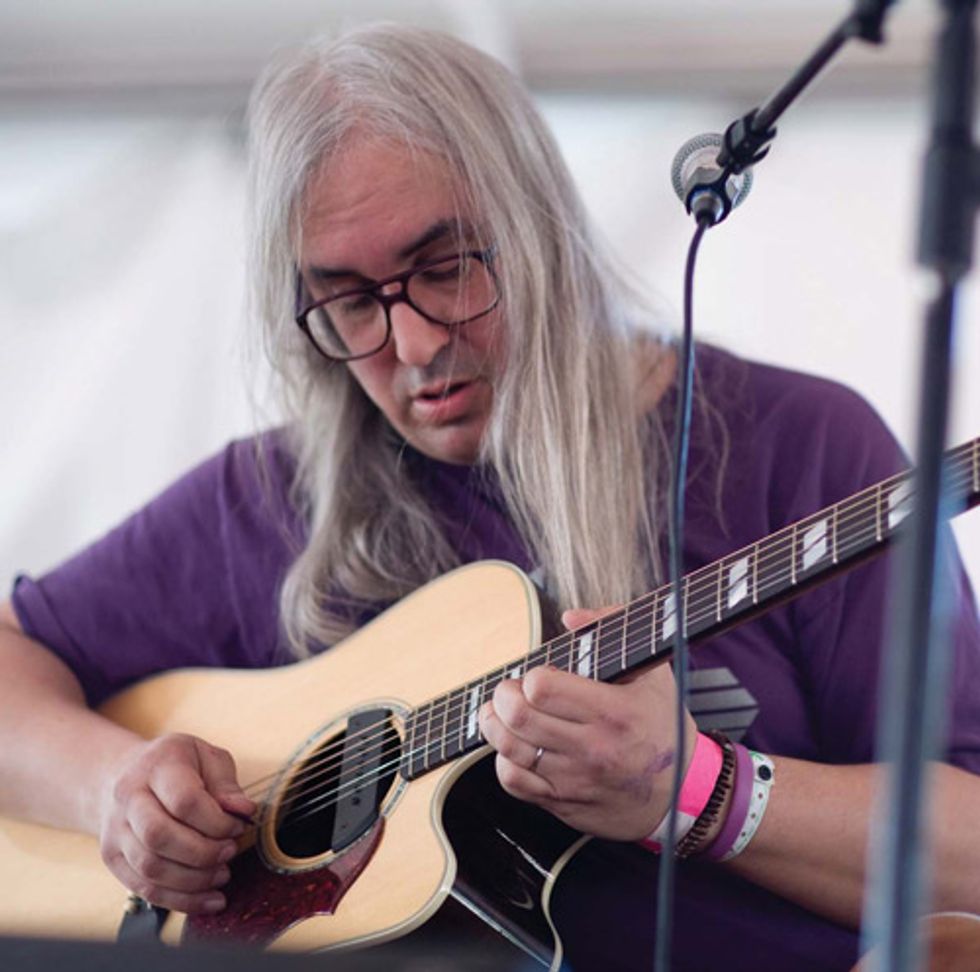
J Mascis playing a Gibson Songwriter dreadnought outfitted with a Sunrise
pickup at a March 15, 2008, SXSW solo gig. Photo by Brian Birzer
J Mascis’ Dinosaur Jr. broke onto the burgeoning indie music scene just before Nirvana set off a seismic shift in the music industry in the early ’90s. And in many respects Dinosaur Jr.—along with bands like Sonic Youth, the Minutemen, and Mission of Burma—set the stage for Nirvana and the rest the alternative music movement.
While the rise of indie felt like nothing short of a musical revolution, the party didn’t last. And somewhat ironically, indie artists became the new mainstream. But while success changed other band’s agendas, Dinosaur Jr. stuck to their original sensibilities—making albums riddled with hooks and polluted with thick layers of sonic chaos.
Mascis (born Joseph Donald Mascis) formed the band with bassist Lou Barlow and drummer Emmett Jefferson “Murph” Murphy III more than 25 years ago in Amherst, Massachusetts. His droning vocals and controlled-noise guitar work were the backbone of the band’s sound, and his style—a fusion of punk and classic-rock moves—was revelatory at the time. He often included fierce guitar solos in Dinosaur songs at a time when solos bordered on passé in indie circles. They also reflected Mascis’ uncommon compositional chops—they were integral to the song while being lyrical, rabid, and punctuated with wild, out-of-control bends.
In the late ’90s, Dinosaur Jr. disbanded and Mascis went on to form J Mascis + the Fog. But Dinosaur reunited in 2005 for a short tour, and their early records were also reissued that year. In 2007 and 2009, the band also recorded new material for the critically acclaimed albums Beyond and Farm. But recent years have also brought out a different side of Mascis’ musical persona. In 2008, he released J + Friends Sing + Chant for Amma, a folk-influenced album featuring devotional songs dedicated to Indian saint Lady Amma (Sri Mata Amritanandamayi Devi).
This year’s Several Shades of Why is Mascis’ first solo studio album and first acoustic album. Sonically, it is a departure from the Dinosaur Jr. sound, offering many surprises like the contrapuntal interplay heard in the intros to songs like “Several Shades of Why” and “Too Deep.” Of course, Mascis also includes gnarly fuzziness on the record, but rather than all-out sonic barrage, it appears in the form of elegantly subdued fills like in “Where Are You” or as backdrops like the haunting theme in “Can I.”
Mascis is a quirky, one-of-a-kind character. He’s also a massive gear fiend. Although his instrument of choice is a Fender Jazzmaster—in 2007 Fender honored Mascis with his own purple-sparkle signature Jazzmaster—he’s a big collector of vintage guitars. And he finds them the same way we all do—by obsessively scouring internet listings.
We recently caught up with Mascis—whose wry, taciturn disposition distinctly contrasts with his over-the-top, purple-sparkle Jazzmaster—to get the details on his vintage guitar collection and his beautiful unplugged excursions on Several Shades of Why.
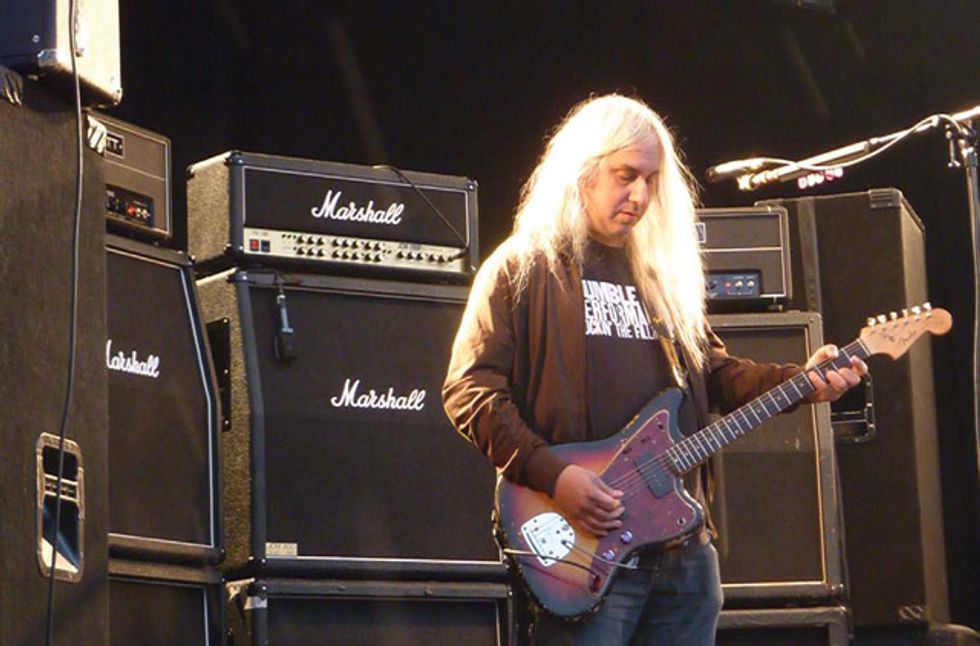
Mascis and his trademark triple-stack array—in this case, a Marshall JCM 2000 TSL 100 head and two
Hiwatt Custom 100 DR103 heads—playing live with Dinosaur Jr. at the Bukta Festival in Tromsø,
Norway, July 16, 2010. The amps are mic'd with Sennheiser e609s. Photo by Simon McKenzie
How did Several Shades of Why come about?
I used to play a lot of acoustic solo shows, and a friend of mine—Megan Jasper, who works at Sub Pop records—had always wanted me to do a record like that, because she was into the shows. It just took a long time before it seemed like the right time. It was recorded at my house, although some guests on the album recorded at other places.
Who are some of the guests?
A longtime friend of mine named Kurt Fedora, Kurt Vile, Matt Valentine, Sophie Trudeau from Godspeed You! Black Emperor and Silver Mount Zion, Ben Bridwell from Band of Horses, Kevin Drew from Broken Social Scene, Paul Jenkins from Black Heart Procession, and Suzanne Thorpe from Mercury Rev and Wounded Knees.
What was the writing process like for this album—and did you have to make any stylistic adjustments to accommodate the acoustic?
No. It was probably the same as usual—I just kind of write on the guitar, and then write lyrics more toward the end, before I have to sing them. I use my iPhone to record ideas and then send it to my email.
I heard that you also write songs while watching TV.
Yeah, it just passes the time. Maybe it helps that I’m not thinking too much about what I’m playing. I just hope that something might come through.
Did you write all the parts—including the string melodies— yourself, or was it a collaborative effort?
For the strings, I wrote one section and Sophie did the other parts. A lot of the guitar people on the album are just playing whatever—they’d play a lot of stuff and I’d just pick out things that I liked. So, yeah, we were just jamming.
What changes—lyrically and musically—do you notice in your songwriting since the inception of Dinosaur Jr.?
At the beginning, I put a lot more parts in the songs—we just had tons of different parts all the time. That’s the main difference, I guess. Now, I feel comfortable to just sometimes have two parts, instead of, like, 20 parts to the song.
In the past, you’ve cited some classic-rock influences, although your music doesn’t always reflect that. What influences have remained with you throughout our career?
The Stones, the Stooges, the Wipers . . . they all still influence me. I collect new ones, but the old ones are still there. I always bought a lot of records. What do I have that’s new? Let’s see . . . I just heard this band Soft Moon that I liked. They sounded pretty cool, kind of like a Joy Division and Cabaret Voltaire kind of vibe.
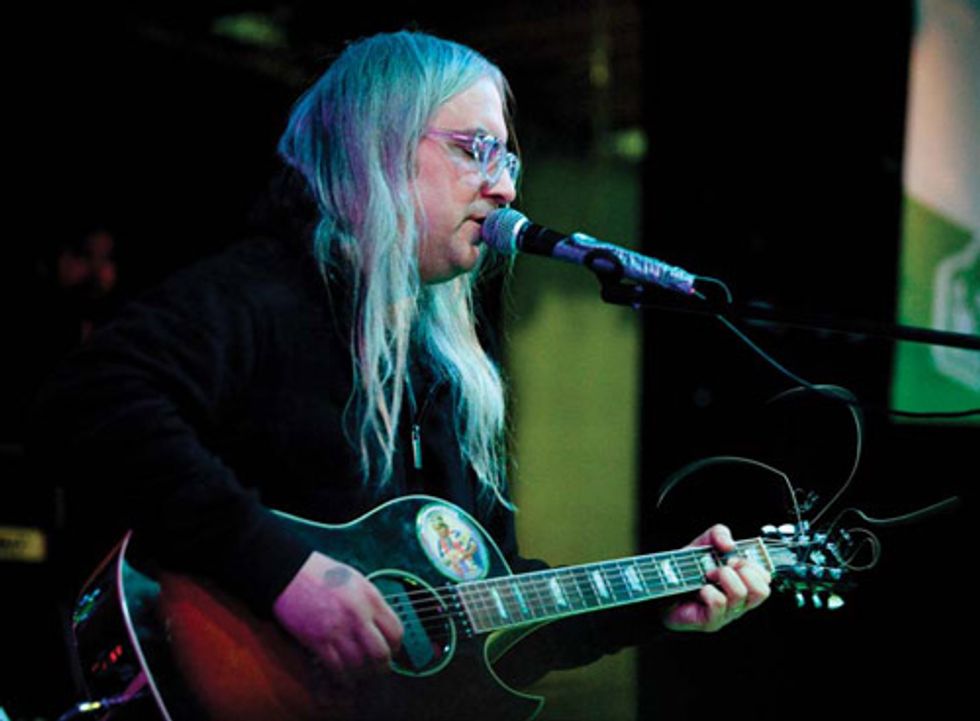
Mascis and a Sunrise-pickup-equipped Gibson CF-100 playing at the
2010 SXSW festival. Photo by Kelly Davidson | etchedonfilm.com
What acoustic guitars did you use on the album?
Mostly a Martin 000-18. I can’t remember the exact year, but it’s from the ’50s. Then I have a Gibson CF–100 that I play live. I also have a Martin D-28 that I use sometimes.
Did you mic the guitars or use a piezo pickup?
Mostly mic’d, unless it’s through some effects. If it’s through a pickup, I usually use a Sunrise.
Songs like “Where Are You,” “Can I,” and “What Happened” feature distorted guitar parts. Were they recorded with acoustic or electric guitars?
It’s acoustic through a fuzz pedal.
All of it?
Yeah.
And which fuzz pedal did you use for those parts?
I think a lot of those parts were recorded when I was using a fuzz that Jim Roth, the guitarist in Built to Spill, made. I think it’s a copy of a Tone Bender, although I don’t know which one, MKI or MKII.
Was it hard to keep the fuzzed-out acoustic from feeding back and going nuts?
Nah. I’m used to that battle, so it doesn’t bother me.
Other than the tambourine on “Not Enough,” there’s no drums or percussion on the album. Why?
Just so it didn’t sound like all my other stuff. If I put drums on it, then I’ll start putting in other guitars. I just wanted to try and make it sound a little different somehow.
In addition to your Several Shades of Why tour and some Dinosaur Jr. shows, you have some Indian kirtan and devotional singing shows lined up. How did that come about?
Just through Lady Amma. She’s kind of like a Mother Teresa figure and has a lot of charities. She has a lot of music at her programs, and I wanted to contribute something—to play there and try to relate to the people who wouldn’t necessarily be into my music.
Are you going to continue to pursue this more acoustic sound in the future or are there no set plans?
I don’t have any plans, really.
Okay. Let’s switch gears a bit and talk about the guitar that you’ve been famous for over all these years. What’s the story behind your first Jazzmaster?
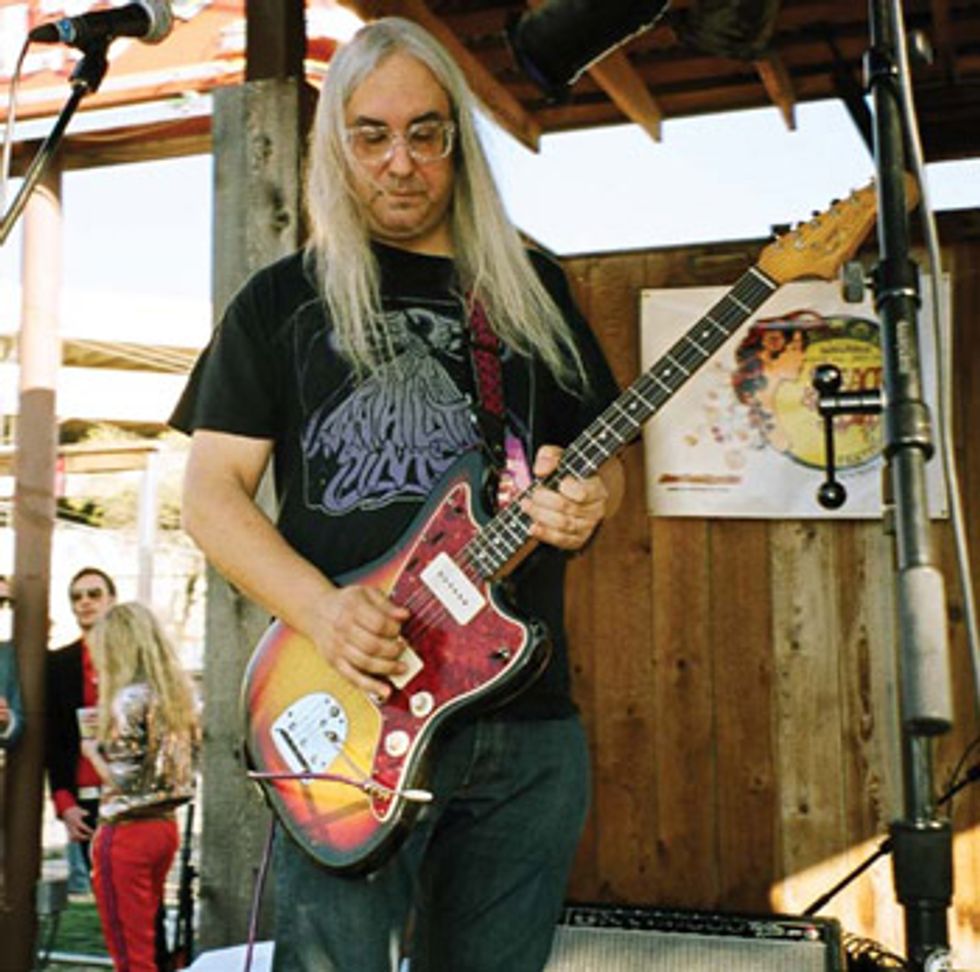 |
Where is that one now—do you still have it, or did you sell it along the way?
I sold it to the Experience Music Project, this museum in Seattle.
If you had gotten the Strat you originally wanted, would that have changed your career at all?
Yeah, probably. For one thing, I probably wouldn’t have a signature model Strat.
You favor a high action on your guitars, right? I heard your motto is that action can never be too high, only too low.
Whenever I get the guitars set up, the [repair] guys are always like, “We can fix the action,” but I always like the action super high—just so I can bend the strings, I guess. Jumbo frets also seem easier for me. I always use new strings and they’re pretty slippery. If I didn’t use new strings, they’d break a lot. So I change them every day.
Live, how many backup guitars do you have waiting in case of a string break?
I’ve done a lot of shows with just two guitars. I’ve been breaking the B string lately, so after half an hour I switch to the other guitar, and the guy will change the B string before it breaks. That’s worked out. I use .010s for strings.
What’s the origin of the purple sparkle?
It’s just two things that I like together. I like sparkly things from playing drums—they always had blue sparkles or silver sparkles, and I had painted some of my guitars with sparkles. Purple is my favorite color. So it’s a combination I guess.
What does the rest of your electric-guitar rig consist of, and how has it evolved over the years?
I’ve tried to get it smaller. At one point, I had a suitcase with stuff in it, and then one day I got this giant rack that was like a refrigerator. From then on, I’ve been trying to scale it down from there. Now I’ve just got a big pedalboard, and everything’s just on the board.
What pedals do you have on there?
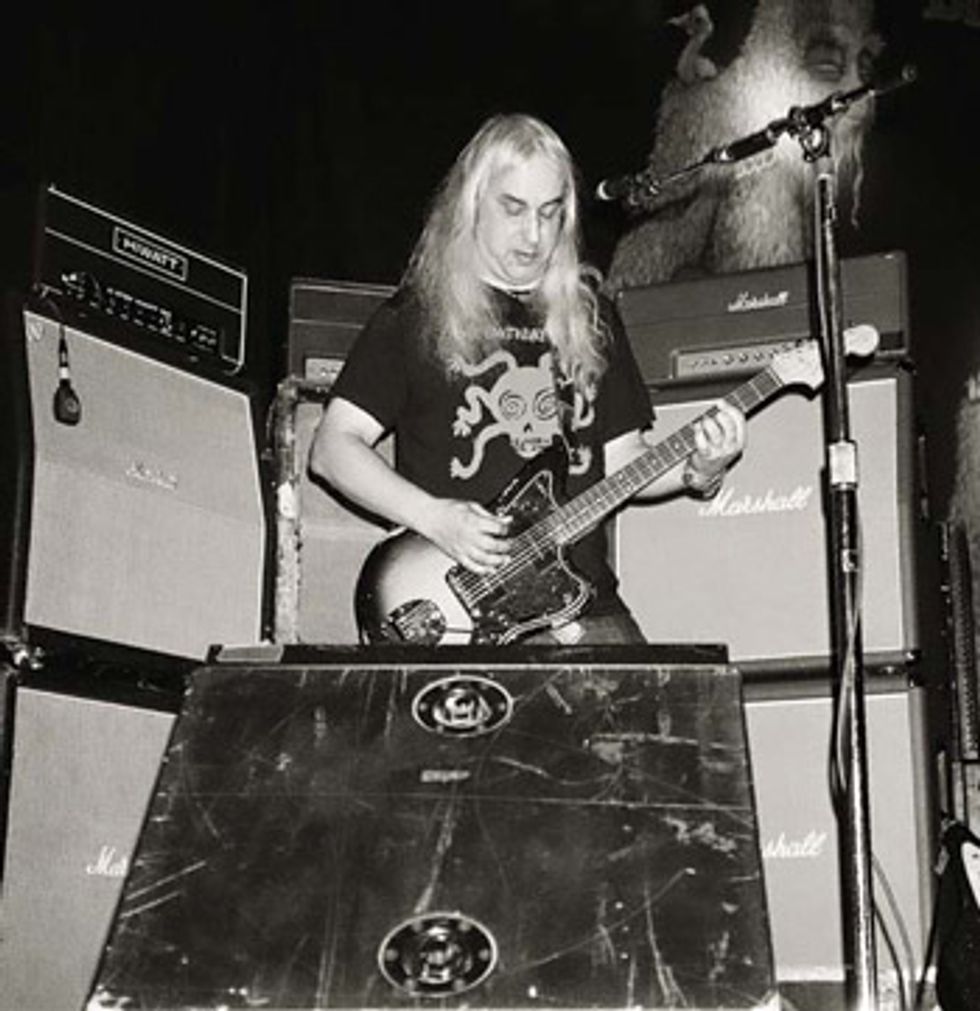 |
And what amps are you using?
I use two old, 100-watt plexi Marshalls and then two 100- watt Hiwatts. They all have EL34 tubes.
Which pieces of gear have stayed with you since the beginning?
The Big Muff and the Electric Mistress, I guess, are the two things I first had and still use.
Tell us about some of your vintage guitars. Which are your favorites?
A ’58 Telecaster is my favorite one, I guess. I’ve had it for a long time. I used to take it out on the road but, yeah, then I stopped.
Yeah, it’s too risky. You had some valuable stuff stolen in 2006 after a gig in Brooklyn, right?
Yeah, luckily I didn’t have it there. For simplicity, I just have Jazzmasters. At one point, I had, like, three Jazzmasters and two Teles, and it got too confusing.
Where do you find your vintage instruments?
Wherever. I guess now the internet a lot. But it’s kind of hard to buy a guitar without playing it.
If you find something on, say, Craigslist, do you go buy it in person?
Yeah, but anything that seems to be good on Craigslist seems to be too far away. I wanted to look at a guitar recently, but it was like an hour and half away. It’s just like, “Eh . . . .” It would also be uncomfortable if it’s just some guy and not a store, and I was like “Uh, no, I don’t like your guitar. See ya later.”
Even if the deal didn’t go through, he’d get a good story out of it . . .
Yeah, I don’t know . . . in certain circles. I drove to Vermont and bought a Jazzmaster from a guy who lived in a trailer, and that was pretty cool [laughs].
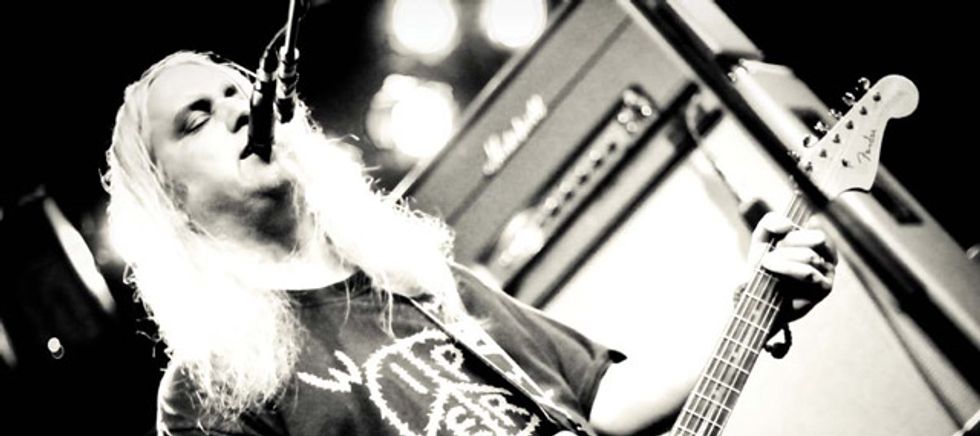
Mascis onstage at the Brooklyn Bowl in Brooklyn, New York, on
January 18, 2010. Photo by A Horse With No Name Photography
Mascis’ Gearbox
Guitars
Sunburst 1963 and ’65 Fender Jazzmasters, Fender J Mascis Jazzmaster, 1950s Martin 000-18, Gibson CF-100 and Martin D-28 F acoustics with Sunrise pickups
Amps
Late-’60s Marshall plexi Super Bass head, late-’60s Marshall plexi Super PA head, early-’70s Hiwatt Custom 100 DR103 head, Marshall 4x12 cabs, late-’70s or early-’80s Hiwatt Custom 100 1x12 combo used as a wedge monitor
Effects
Bob Bradshaw pedalboard controlling Custom Z. Vex pedal containing two Box of Rocks units, custom Dr. Scientist pedal containing a Woofer Wailer and a Frazz Dazzler, Electro-Harmonix Big Muff, RMC wah, Electro-Harmonix Electric Mistress, Megavibe Uni-Vibe copy, Eventide TimeFactor delay pedal, Boss RV-5 reverb
Miscellaneous
Dunlop 1.14 mm Tortex picks, DR Tite-Fit MT-10 (.010–.046) strings, Monster speaker and pedalboard cables, Mogami instrument cable














![Rig Rundown: Russian Circles’ Mike Sullivan [2025]](https://www.premierguitar.com/media-library/youtube.jpg?id=62303631&width=1245&height=700&quality=70&coordinates=0%2C0%2C0%2C0)
















![Rig Rundown: AFI [2025]](https://www.premierguitar.com/media-library/youtube.jpg?id=62064741&width=1245&height=700&quality=70&coordinates=0%2C0%2C0%2C0)




















 Zach loves his Sovtek Mig 60 head, which he plays through a cab he built himself at a pipe-organ shop in Denver. Every glue joint is lined with thin leather for maximum air tightness, and it’s stocked with Celestion G12M Greenback speakers.
Zach loves his Sovtek Mig 60 head, which he plays through a cab he built himself at a pipe-organ shop in Denver. Every glue joint is lined with thin leather for maximum air tightness, and it’s stocked with Celestion G12M Greenback speakers.






